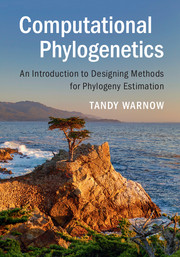Book contents
- Frontmatter
- Dedication
- Contents
- Preface
- Glossary
- Notation
- PART I BASIC TECHNIQUES
- PART II MOLECULAR PHYLOGENETICS
- Appendix A Primer on Biological Data and Evolution
- Appendix B Algorithm Design and Analysis
- Appendix C Guidelines forWriting Papers About Computational Methods
- Appendix D Projects
- References
- Index
Appendix A - Primer on Biological Data and Evolution
Published online by Cambridge University Press: 26 October 2017
- Frontmatter
- Dedication
- Contents
- Preface
- Glossary
- Notation
- PART I BASIC TECHNIQUES
- PART II MOLECULAR PHYLOGENETICS
- Appendix A Primer on Biological Data and Evolution
- Appendix B Algorithm Design and Analysis
- Appendix C Guidelines forWriting Papers About Computational Methods
- Appendix D Projects
- References
- Index
Summary
This chapter will provide a basic introduction to evolution, biological data, and standard approaches to biological data analysis.
Phylogeny Estimation Pipeline
Phylogeny estimation is a multi-step process, and understanding the process is helpful to developing and evaluating methods.
• The biologist identifies a question they wish to answer, and based on the question they select the species and genes they will analyze.
• Sequence data are collected for the species and genes. This may be done by accessing public databases, or by going into the field and gathering specimens. Typically, at the end of this step, for each selected gene and each species, at most one sequence is obtained. Often this is a DNA sequence, but in some cases it may be an RNA or amino acid sequence (also called a “protein sequence”).
• For each gene, a multiple sequence alignment of the different sequences is obtained. This process puts the sequences into a matrix so that the rows correspond to the different species, and the columns represent homologies (nucleotides having a common evolutionary history).
• For each gene, a phylogenetic tree is estimated based on the multiple sequence alignment computed in the previous step. This analysis is almost always based on a statistical model of sequence evolution, and most methods combine graph-theoretic methods with statistical estimation techniques. Furthermore, many methods attempt to solve NP-hard optimization problems, so heuristic techniques are often used.
• Statistical support for the individual branches of each gene tree is computed, typically using methods such as non-parametric bootstrapping. These support values let the biologist assess which aspects of the estimated evolutionary history are considered highly reliable, and which ones are not as reliable.
• Now we have a collection of trees and multiple sequence alignments, one for each gene. When the gene trees are either identical or very similar to each other, then the species tree is often estimated by concatenating the sequence alignments together, and then using standard techniques on the large “super-alignment” to compute a species tree. However, some biological phenomena cause gene trees to be different from each other, so that estimating the species tree can require different techniques, although the choice of technique depends on the cause for the discordance. When the discordance is due to horizontal gene transfer or hybrid speciation, then a phylogenetic network is needed.
- Type
- Chapter
- Information
- Computational PhylogeneticsAn Introduction to Designing Methods for Phylogeny Estimation, pp. 299 - 303Publisher: Cambridge University PressPrint publication year: 2017



